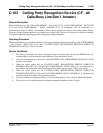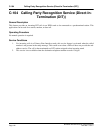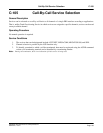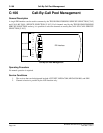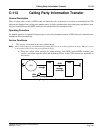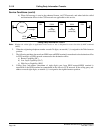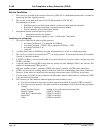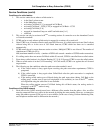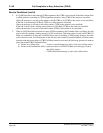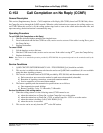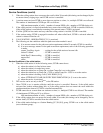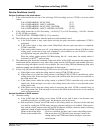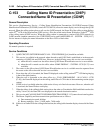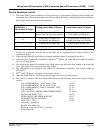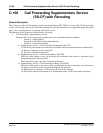
NEAX2400 IPX ISDN Features and Specifications
NDA-24311, Issue 1
Page 149
Call Completion to Busy Subscriber (CCBS) C-148
Service Conditions (cont’d)
Conditions of a called station
1. This service cannot be set when a called station is:
• in the Line Lockout status
• in the Make Busy status
• activating Call Back [C-1] or engaged in Call Back
• activating Call Back – CCIS [C-44] or engaged in Call Back – CCIS
• activating Call Hold [C-6]
• engaged in Attendant Camp-on with Tone Indication [A-1]
• restricted
2. This service can only be activated to D
term
s or analog stations. It cannot be set to the Attendant Console
or I interface terminal.
3. CCBS can be set only when a called station is engaged in a station call or trunk call.
4. Once CCBS is set, it remains effective until cancelled. However, if a called station activates Line Lockout
without being idle or in the case of Call Back time-out, CCBS which has been set is cancelled
automatically.
5. CCBS cannot be set by more than one station at a time. Multiple CCBS is not allowed. The number of
simultaneous CCBSs per LP is:
480 (maximum number of calls) – (number of ISDN calls caused + number of CCBSs under transaction).
6. If a calling station does not answer Call Back within 30 seconds, CCBS is cancelled from a called station.
7. Even when a called station is in a Station Hunting [S-7, S-8, S-9] group, CCBS is set to the called station.
8. When a called station is in the Call Forwarding – All Calls mode, CCBS is set against the call forward
target station.
9. The following are the conditions when the path reservation method is used.
a.) If the called station is busy again upon receiving the path reservation requirement, CCBS is
postponed.
b.) If the called station is busy again when Called Back after the path reservation is completed,
CCBS is cancelled.
c.) If the analog called station goes off-hook during the path reservation (during Call Back to the
calling party), reorder tone is sent (call origination is not available); in case of the D
term
station,
call origination using the called line is not available.
When the calling station answers Call Back during this off-hook status, the analog station is
connected, or the D
term
station is rung.
Conditions of the Q-SIG network
1. Each office in the Q-SIG network must have a different office number from the others. Also, an office
must be connected from every office in the network by dialing the same number. However, a connection
using Sub-address present [S-96] service is not available. (In the case of using Uniform Numbering Plan,
each telephone number must be different in the network.)



